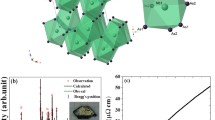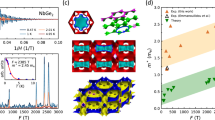Abstract.
High quality samples and absence of superconductivity down to 40 mK make of ZrB2 the best normal state reference system for the superconducting isostructural MgB2. Actually, the question of pairing has to be focused on the electron-phonon interaction in the normal state. After presenting the resistivity measurements of ZrB2, we explain the details of the Bloch-Grüneisen and Einstein models used to deduce the first results. We then compare experimental de Haas-van Alphen effect data with theoretical Fermi surfaces to present additional results on electron quasi-particle renormalization. The estimations reveal an isotropic and negligible coupling constant of in average \(\left\langle \lambda_{tr} \right\rangle=\) 0.145. The contribution of the coupling to the optical phonon modes is 0.082, in contrast to the known larger coupling of 0.283 [3] to the E2g phonon mode in MgB2.
Similar content being viewed by others
References
J. Nagamatsu, N. Nagakawa, T. Muranaka, Y. Zenitani, J. Akimitsu, Nature (London) 410, 63 (2001)
M. Putti, E. Galleani d'Agliano, D. Marrè, F. Napoli, M. Tassisto, P. Manfrinetti, A. Palenzona, C. Rizzuto, S. Massidda, Eur. Phys. J. B 25, 439 (2002)
T. Masui, K. Yoshida, S. Lee, A. Yamamoto, S. Tajima, Phys. Rev. B 65, 214513 (2002)
F. Monteverde, A. Bellosi, Adv. Eng. Mater. 6, 331 (2004); S.C. Tjong, G. Wang, Adv. Eng. Mater. 6 964 (2004); V. Medri, F. Monteverde, A. Balbo, A. Bellosi, Adv. Eng. Mater. 7, 159 (2005)
R. Heid, K.-P. Bohnen, to be published
H. Rosner, J.M. An, W.E. Pickett, S.-L. Drechsler, Phys. Rev. B 66, 024521 (2002)
The samples used in this work and in RefRosner2, RefDrechs are cut from the same crystal rod, for reference see: S. Otani, Y. Ishizawa, J. Crystal Growth 165, 319 (1996)
E. Forzani, Master Thesis, Universität Göttingen, 2003
F. Bloch, Z. Phys. 52, 555 (1929); F. Bloch, Z. Phys. 59, 208 (1930)
A.V. Sologubenko, J. Jun, S.M. Kasakov, J. Karpinski, H. Rott, cond-mat/0111273 (unpublished)
J.M. Ziman, Electrons and Phonons (Oxford, Clarendon Press 1960) pp. 357–382
The transformation consists in a series of substitutions applied when the Debye integral is expressed as in (3). The development of the integral (3) to \(\label{eqn:Jm2} J_{m}\left(\frac{\Theta_{D}}{T}\right)= \int^{\Theta_{D}/T}_{0}\frac{z^m\:dz}{e^z +e^{-z} -2}\ , %\label{eqn:Jm2} \) after considering that \(\label{eqn:hyp} {\rm cosh} z= \frac{e^z +e^{-z}}{2} \ \ \textrm{and} \ \ {\rm sinh}^2 \left(\frac{z}{2}\right)= \frac{{\rm cosh{\it z}} -1}{2}\ , %\label{eqn:hyp} \) reduces into \(\label{eqn:Jm3} \int^{\Theta_{D}/T}_{0}\frac{z^m}{2^2}\frac{dz}{{\rm sinh}^2\left(\frac{z}{2}\right)} = \int^{\Theta_{D}/T}_{0}z^{m-2} \left[\frac{\frac{z}{2}}{{\rm sinh}\frac{z}{2}}\right]^2dz\ . %\label{eqn:Jm3} \) Using \(\frac{z}{2}\) as integration variable, \(J_{m}(\frac{\Theta_{D}}{T})\) assumes the form in equation (5)
E. Grüneisen, Handb. d. Phys. XIII, 18
X.H. Chen, Y.S. Wang, Y.Y. Xue, R.L. Meng, Y.Q. Wang, C.W. Chu, Phys. Rev. B 65, 024502 (2001) and references therein
M. Mott, Proc. Phys. Soc. 47, 571 (1935)
A. Wilson, Proc. Roy. Soc. A 167, 580 (1938)
I.I. Mazin, O.V. Dolgov, Phys. Rev. B 45, 2509 (1992)
This approach was applied to MgB2 in RefPutti1: sintered bulk MgB2 shows a ΘD of 1050 K and \(\acute{\rho}\) of 4.9×10-1 μΩ cm/K.
J.M. Ziman, Electrons and Phonons (Oxford, Clarendon Press 1960), pp. 257-264
N.W. Ashcroft, N.D. Mermin, Solid State Physics (Holt-Saunders International Editions, 1981), pp. 244–251
F.J. Pinski, P.B. Allen, W.H. Butler, Phys. Rev. B 23, 5080 (1981)
D.J. Scalapino, in Superconductivity, edited by R.D. Parks (M. Dekker, New York, 1969), Vol. 1, pp. 449–500
W.L. McMillan, Phys. Rev. 167, 331 (1968)
The substitution in (30) of the integration variable \(\omega \rightarrow x = \frac{\hbar \omega}{2 k_B T}\) and the introduction of the Debye frequency \(\omega_D=\frac{k_B}{\hbar}\Theta_D\) produces the resistivity formula (31)
T.I. Jeon, D. Grischkowsky, Phys. Rev. L 78, 1106 (1997)
C.N. King, H.C. Kirsh, T.H. Geballe, Solid State Comm. 9, 907 (1971)
Method adopted to transport measurements at single-crystal MgB2 in RefMasui
P.B. Allen, W.W. Schulz, Phys. Rev. B 47, 14434 (1993)
P.B. Allen, R.C. Dynes, Phys. Rev. B 12, 905 (1975)
After writing the integration variable of (41) explicitely, \(\omega = \frac{2 k_B T}{\hbar \omega}x\), and introducing the Einstein frequency as \(\omega_E=\frac{k_B}{\hbar}\Theta_E\), the use of the relation \(\delta(k x) = \frac{1}{\left| k \right|} \delta(x)\) trans- forms the delta function into \(\label{eqn:deltavarchange} \delta(\omega-\omega_E) = \frac{\hbar}{2 k_B T} \delta\left(x-\frac{\Theta_E}{2T}\right) \ . %\label{eqn:deltavarchange} \) Considering that \(\label{eqn:deltaint} \int^{+\infty}_{-\infty} f(x) \delta(x-a) dx = f(a) \ \ \textrm{with} \ \ -\infty < a <+\infty \ , %\label{eqn:deltaint} \) the resistivity formula reduces to (42)
S.-L. Drechsler, private communications
K.-P. Bohnen, R. Heid, B. Renker, Phys. Rev. L 86, 5771 (2001) and references therein
K. Kunc, I. Loa, K. Syassen, R.K. Kremer, K. Ahn, J. Phys.: Cond. Matter 13, 9945 (2001)
D. Shoenberg, Magnetic oscillations in metals (Cambridge, 1984)
For a complete treatise see Chapter 2 and 3 in RefForzani
For all our experiments we found that 0.3< m*t <1.2, with m*≈ 0.5 and \(\left\langle B\right\rangle=9.3\) T, so that the exponential term in equation (54) cannot be neglected. On the contrary, if e-2m*t≪1, the direct plot of ln(A/T) against T/B would give immediately a straight line of slope -bm*
Results from: T. Tanaka, Y. Ishizawa, E. Bannai, S. Kawai, Solid State Comm. 26, 879 (1978). For the technique see also: Y.Ishizawa and T. Tanaka, Inst. Phys. Conf. Ser. No. 75, 29 (1986)
S.-L. Drechsler, H. Rosner, J.M. An, W.E. Pickett, V.D.P. Servedio, T. Mishonov, E. Forzani, K. Winzer, J. Low Temp. Phys. 131, 1175 (2003)
The amplitudes of the α and β frequencies show nearly no temperature dependence at our low temperatures. This behaviour is caused by the very small effective masses mα, β*. The scattering of the data prevent any evaluation of mα, β*
B.A. Sanborn, P.B. Allen, D.A. Papaconstantopoulos, Phys. Rev. B 40, 6037 (1989)
H. Rosner, private communications
Author information
Authors and Affiliations
Corresponding author
Rights and permissions
About this article
Cite this article
Forzani, E., Winzer, K. Experimental study of electron-phonon properties in ZrB 2. Eur. Phys. J. B 51, 29–40 (2006). https://doi.org/10.1140/epjb/e2006-00190-1
Received:
Published:
Issue Date:
DOI: https://doi.org/10.1140/epjb/e2006-00190-1




